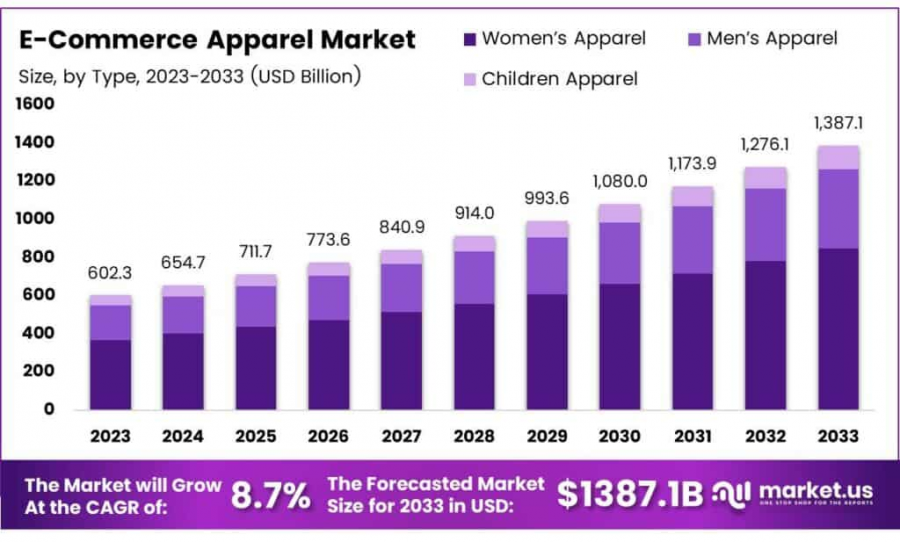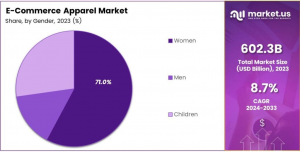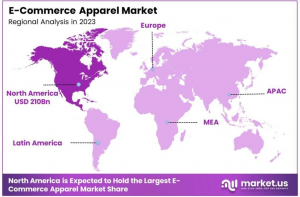
E-Commerce Apparel Market to Surge to $1387.1 Billion by 2033, 8.7% CAGR Expected
E-Commerce Apparel Market size is expected to be worth around USD 1387.1 Billion by 2033, from USD 602.3 Billion in 2023, growing at a CAGR of 8.7%.
NEW YORK, NY, UNITED STATES, January 24, 2025 /EINPresswire.com/ -- Market Overview
The Global E-Commerce Apparel Market size is expected to be worth around USD 1387.1 Billion by 2033, from USD 602.3 Billion in 2023, growing at a CAGR of 8.7% during the forecast period from 2024 to 2033.
The E-Commerce Apparel Market refers to the online retail sector dedicated to the sale of clothing and fashion-related items through digital platforms. This market includes a wide variety of apparel types, including men’s, women’s, and children’s clothing, as well as accessories and footwear, all available for purchase via websites, mobile apps, and other online channels.
The E-Commerce Apparel Market has evolved significantly over the past decade, driven by the increasing penetration of the internet, smartphones, and changing consumer shopping habits. The growth of e-commerce in apparel retail has fundamentally reshaped the fashion industry, making it more accessible and personalized. Consumers increasingly prefer the convenience of shopping for clothing online, where they can explore a wide variety of brands and styles, compare prices, and enjoy easy returns—all from the comfort of their homes.
Key trends shaping this market include the rise of online marketplaces such as Amazon, Alibaba, and niche fashion retailers, as well as the rapid growth of mobile commerce (m-commerce). Social media platforms and influencer marketing have also become critical channels for driving brand visibility and consumer engagement.
Companies leveraging advanced technologies such as AI and machine learning for personalized recommendations and seamless customer experiences are expected to thrive in this competitive environment. However, challenges remain, including logistics issues, returns management, and the need for differentiation in a crowded market.
The E-Commerce Apparel Market is poised for continued growth in the coming years. The ongoing shift toward digital-first shopping experiences is supported by factors such as increasing internet penetration, improved logistics infrastructure, and the growing popularity of smartphones, particularly in emerging markets.
The E-Commerce Apparel Market presents significant opportunities for both new entrants and established players. For new businesses, the key lies in carving out a niche or differentiating through unique value propositions such as sustainable fashion, inclusive sizing, or customizations. With increasing digital adoption globally, new players can tap into underserved regions and demographics, leveraging targeted online marketing and influencer collaborations to build brand awareness.
For existing players, growth opportunities include expanding product offerings, enhancing the online shopping experience through innovative technologies (like virtual fitting rooms), and optimizing logistics for faster delivery. As consumer preferences shift toward convenience, personalization, and sustainability, established brands that align with these trends are well-positioned for sustained growth. Additionally, partnerships with e-commerce platforms or exploring multi-channel retailing can expand reach and improve brand visibility in a competitive landscape.
Curious About Market Trends? Request Your Complimentary Sample Report Today: https://market.us/report/e-commerce-apparel-market/free-sample/
Key Takeaway
-The global e-commerce apparel market is projected to grow from USD 602.3 billion in 2023 to USD 1387.1 billion by 2033, at a CAGR of 8.7%.
-Women’s apparel dominates the e-commerce apparel market with a 68.7% share in 2023, driven by the preference for online shopping and availability of more style and size options.
-Women hold a 71% share in the gender analysis of the e-commerce apparel market in 2023, influenced by diverse product offerings and frequent purchasing habits.
-The discounted pricing model leads the market due to consumer demand for affordability, accounting for a significant market share in 2023.
-North America holds a commanding 35% market share in the e-commerce apparel sector, propelled by strong digital infrastructure and high consumer spending.
Use Cases
• Fast Fashion: E-commerce platforms have made it easy for consumers to access the latest fashion trends almost immediately. Brands like Zara and H&M cater to this demand, quickly turning runway trends into ready-to-wear items available for online purchase.
• Subscription Boxes: Services like Stitch Fix allow consumers to receive personalized clothing items based on their preferences and sizes. The subscription model provides convenience, styling advice, and easy returns, enhancing the shopping experience.
• Second-Hand and Sustainable Fashion: With rising awareness around sustainability, second-hand e-commerce platforms like ThredUp and Poshmark have become popular. Consumers are increasingly seeking pre-loved clothing as an eco-friendly alternative to new garments.
• Virtual Fitting Rooms: With advancements in augmented reality, online retailers are offering virtual fitting rooms, allowing customers to try on clothes digitally. This innovation is expected to reduce return rates and increase consumer confidence when shopping for apparel online.
• Global Reach and Niche Markets: E-commerce allows small apparel brands to reach global markets without needing physical stores. Niche clothing lines, such as vegan leather or plus-size fashion, can thrive online, offering unique products that may not be widely available in brick-and-mortar shops.
Driving Factors
• Convenience of Online Shopping: The ease of browsing and purchasing apparel from the comfort of home is a major driver for the growth of e-commerce in the fashion industry. Consumers appreciate the convenience and time savings.
• Wide Variety and Availability: E-commerce platforms offer a vast range of brands, styles, and sizes, making it easier for consumers to find exactly what they want. This variety attracts more buyers to online stores.
• Personalized Shopping Experience: E-commerce platforms use AI and data analytics to provide personalized recommendations based on past purchases and browsing history. This tailored shopping experience boosts sales and customer loyalty.
• Discounts and Promotions: Online apparel retailers often offer discounts, flash sales, and promotions that attract cost-conscious shoppers. The ability to compare prices and find deals is a significant draw for consumers.
• Global Reach: E-commerce enables apparel brands to reach a global audience. Customers from all over the world can access international fashion trends, which is fueling the growth of global online apparel sales.
Report Segmentation
In 2023, women’s apparel led the e-commerce apparel market with a 68.7% share, driven by the growing trend of online shopping, a wider range of styles and sizes, and the convenience of home trials and easy returns. Women also dominated the gender segment with a 71% share, thanks to diverse product offerings and the impact of fashion trends, supported by targeted digital marketing. Additionally, the discounted pricing model was the most popular, as consumers sought affordable options during uncertain economic times, which allowed businesses in this segment to attract price-sensitive shoppers and grow their market presence.
By Type
~Women’s Apparel
~Men’s Apparel
~Children Apparel
By Gender
~Women
~Men
~Children
By Pricing Model
~Discounted
~Premium
Ready to Act on Market Opportunities? Buy Your Report Now and Get 30% off: https://market.us/purchase-report/?report_id=134890
Regional Analysis
The e-commerce apparel market shows varied growth trends across regions. North America leads the sector with a 35% market share, valued at approximately USD 210 billion. This dominance is due to the region’s strong digital infrastructure, high consumer spending, and a culture that embraces online shopping, creating a favorable environment for e-commerce apparel businesses.
Growth Opportunities
• Growing Preference for Online Shopping As more consumers shift to online shopping for clothing, e-commerce platforms have a prime opportunity to expand their customer base. This includes offering easy-to-navigate websites, fast shipping, and seamless returns policies.
• Social Media and Influencer Marketing Leveraging social media platforms and influencers to promote apparel brands is an effective way to reach younger, fashion-forward consumers. Collaborations and sponsored posts can drive traffic and sales.
• Subscription and Rental Models Subscription-based services for clothing rental or curated fashion boxes are gaining popularity. By offering flexibility and convenience, these models appeal to consumers who want to wear new clothes regularly without the full investment.
• Sustainability in Fashion Sustainable fashion is becoming a growing trend. Brands that prioritize eco-friendly materials, ethical production methods, and transparency in their supply chains are more likely to attract environmentally-conscious consumers.
• Personalized Shopping Experiences Offering personalized recommendations, size advice, and virtual try-on features can enhance the customer shopping experience. By leveraging AI and data analytics, e-commerce platforms can increase conversion rates and customer satisfaction.
Key Players
~Wal-Mart Inc
~EBay Inc
~Shopify Inc
~Amazon, Inc
~JDcom, Inc
~Alibaba Group Holding Limited
~Rakuten Group, Inc
Not Sure? Request a Sample Report and See How Our Insights Can Drive Your Business: https://market.us/report/e-commerce-apparel-market/free-sample/
Trending Factors
• AI and AR for Virtual Try-Ons: E-commerce platforms are utilizing artificial intelligence and augmented reality to offer virtual try-on features, enhancing the online shopping experience and reducing return rates.
• Fast Fashion on Demand: The ability to quickly produce and distribute fashion items that reflect current trends is driving the e-commerce apparel market, appealing to the desire for immediate gratification among consumers.
• Sustainability and Ethical Fashion: There is a significant trend towards sustainable and ethically produced apparel, influenced by consumer demand for brands that prioritize environmental and social responsibility.
• Influencer Marketing: Social media influencers play a crucial role in shaping consumer preferences and driving sales in the apparel industry through targeted promotions and collaborations.
• Subscription and Rental Services: The rise of subscription and rental services for clothing offers consumers a way to constantly refresh their wardrobe without the need to purchase clothes, appealing to budget-conscious and environmentally aware shoppers.
Restraining Factors
• Logistical and Delivery Challenges: E-commerce apparel companies often face issues with timely and efficient delivery, especially for international orders. Delays, high shipping costs, and complicated return processes can lead to customer dissatisfaction and lost sales.
• Size and Fit Issues: One of the main challenges in online apparel shopping is the inability to try on items. Incorrect sizing or dissatisfaction with the fit is common, leading to high return rates, which affect profitability and customer experience.
• Intense Price Competition: With the convenience of online shopping, consumers can easily compare prices from different retailers. This leads to aggressive price competition, making it difficult for e-commerce companies to maintain healthy margins while also attracting customers.
• Changing Consumer Preferences: Fast fashion trends change quickly, and keeping up with the ever-evolving consumer demand can be difficult. E-commerce companies must constantly refresh their product offerings to stay relevant, which can be costly and logistically complex.
• Cybersecurity and Data Privacy Concerns: E-commerce platforms are increasingly targeted by cybercriminals, and concerns about data breaches and online fraud can deter customers from shopping online. Brands that don’t prioritize security may face reputational damage, loss of trust, and potential legal challenges.
Conclusion
Vegan Womens Fashion Market: https://market.us/report/vegan-womens-fashion-market/
Pet Mobility Aids Market: https://market.us/report/pet-mobility-aids-market/
Winter Wear Market: https://market.us/report/winter-wear-market/
Cat Toys Market: https://market.us/report/cat-toys-market/
Thermal Underwear Market: https://market.us/report/thermal-underwear-market/
Lawrence John
Prudour
+91 91308 55334
Lawrence@prudour.com
Visit us on social media:
Facebook
LinkedIn
Distribution channels: Consumer Goods
Legal Disclaimer:
EIN Presswire provides this news content "as is" without warranty of any kind. We do not accept any responsibility or liability for the accuracy, content, images, videos, licenses, completeness, legality, or reliability of the information contained in this article. If you have any complaints or copyright issues related to this article, kindly contact the author above.
Submit your press release


